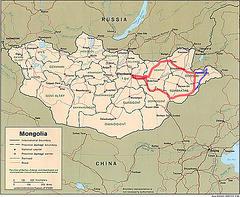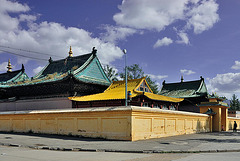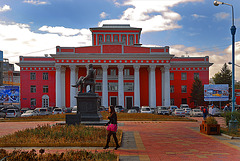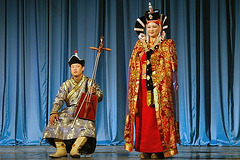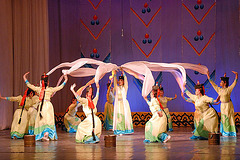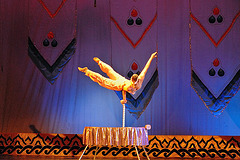
Mongolia, on the tracks of Genghis Khan
Many of my relatives, acquaintances and friends asked me why I choose Mongolia for an holiday destination. The hard weather condition, the endless width of the steppe, the extremely bad dirt roads, the anomalous cuisine, all of this speaks against a visit in this giant country.
I like to learn about the Mongolian people, about its ancient culture and to experience the hard life style and the anci…
(read more)
My Mongolia-Tour Aug.-Sept. 2009
| |
|
The whole route was arranged by our tour agent "e-mongol.com", who arranged all the travel permits from Mongolian authorities. The blue route was restricted so we couldn't go to the Buir Lake. A a particular permit from the Military Authority in Ulaanbaatar was missing.
Mongolia-Tour Aug.-Sept. 2009
| |
|
Its the east part of Mongolia where we went on our tour. Mongolia with its 1,564,116 km² is three times bigger than Germany (357,104 km²), Austria (83,871 km²) and Switzerland (41,285 km²) together. The part we went on our tour passes approximately one in fourth of the whole country.
Chinggis Khaan Airport Ulaanbaatar
| |
|
It is the largest international air facility in the country, and the only facility to offer scheduled international flights. The airport is the main base of operations for national carriers MIAT Mongolian Airlines, Eznis Airways and Aero Mongolia.
The airport was formerly known as Buyant Ukhaa Airport until it was renamed to Chinggis Khaan (Genghis Khan) International Airport to celebrate the 800th anniversary of the establishment of a Mongolian State on 21st of December 2005.
In front of the Gandan Monastery
| |
|
It is one of the few monasteries in the country that escaped the communist purges during the 1930s. Many pilgrims and visitors come to the complex which is very similar to Monasteries in Tibet.
Golden Chituokhan Buddhist Temple at Gandan Monast…
| |
|
|
It is one of the earliest buildings of Gandan, and this is where Tsong Khapa and successive Gandan abbots lived. The 7th Dalai Lama added an ornate golden pinnacle to the building. The temple contains many Buddhist Sutras, ancient codes and other personal belongings of Tsong Khapa. The "Yanbajian Hall" is a large four-story building with 72 pillars. Building began in 1409 and finished in 1416. A golden pinnacle was added to the hall in 1610 by the 4th Panchen Lama. The outside garden contains the stupa of successive abbots. Inside the hall is a suit of armor belonging to Chinese Emperor Qian Long, who presented it to Gandan in 1757. It is one of Gandan's highly prized treasures. The suit bears an inscription, written in Han, Manchu, Mongol and Tibetan, showing the Qing Emperor's respect of the Buddha.
Inside the Gandan Monastery
| |
|
26.5-meter-high statue of Migjid Janraisig, a Buddhist bodhisattva also known as Avalokitesvara the eighth known as Bogd Khan the Mongolian emperor.
Stupa and other buildings at Gandan Monastery
| |
|
|
The original statue, made of copper, was built after appeals to the Mongolian public; its intent was to restore the sight of Bogd Javzandamba (or the eighth Jebtsundamba, also known as Bogd Khan), who had claimed the title of Emperor of Mongolia. The building of the statue was carried out by Bogd Javzandamba's principal minister, Chin Wan Khanddorj. Russian troops dismantled the original statue in 1938. After the end of the Soviet era, the statue of Migjid Janraisig was rebuilt in 1996, from donations by the Mongolian people. It features 2,286 precious stones and is gilded with gold leaf.
Gandantegchinlen Monastery
| |
|
|
The monastery was established in 1835 by the Fifth Jebtsundamba, then Mongolia's highest reincarnated lama. It became the principal center of Buddhist learning in Mongolia.
In the 1930s, the Communist government of Mongolia, under the leadership of Khorloogiin Choibalsan and under the influence of Joseph Stalin, destroyed all but a few monasteries and killed more than 10.000 lamas.
Gandantegchinlen Khiid monastery, having escaped this mass destruction, was closed in 1938, but then reopened in 1944 and allowed to continue as the only functioning Buddhist monastery, under a skeleton staff, as a token homage to traditional Mongolian culture and religion. With the end of communism in Mongolia in 1990, restrictions on worship were lifted. See Mongolian Buddhism for details.
Downtown in Ulaanbaatar
| |
|
The Blue Sky Tower just finished in constructing and it gives a brand new modern landmark to Mongolia.
It consists of 25 stories and features an international five-star hotel, grade-A commercial office space and penthouse residences in addition to such amenities as meeting and convention facilities, a fitness center with a 20-meter long swimming pool, luxury retail boutique shops as well as various fine dining restaurants. Currently, the construction work is nearly complete and all mechanical and engineering fit-outs are finished. By the end of this year, Blue Sky Tower will be ready to receive its first clients as the offices and residences will be launched along with Blue Sky Lounge at the very top. Upon full opening, Blue Sky Tower will create over 400 new jobs. Moreover, at the onset of the tremendous development of Mongolia’s mining sector, Blue Sky Tower is fully geared to provide foreign investors and their associates with a full range of world-class services.
Opera House in Ulaanbaatar
| |
|
The National Academic Theatre of Opera and Ballet of Mongolia (colloquially called Ulaanbaatar Opera House) opened on 15th of May 1963 and made its opening ceremony on 18th of May 1963 with Tchaikovsky’s Eugene Onegin.
The repertoire includes classical and national ballet (Swan Lake, The Nutcracker) and opera (Madama Butterfly, La Bohème).
The beginnings of a contemporary professional theatre in Mongolia were laid down with the establishment of a National Central Theatre in 1931, which was an extension of the Folk Stadium which was inaugurated in 1927.
We had the pleasure to visit a performance of typical Mongolian dances, concerts, ballets and the unique Mongolian threat singers.
In the center of the city and the Blue Sky Tower
| |
|
|
Mongolia just has 2,671,000 citizens and in Ulaanbaatar living one Million of them.
Ulaanbaatar has a long and mysterious history, and is only now undergoing an industrial revolution. UB is one of the most drab looking cities on the face of the planet, a travesty really, considering it's the capital of one the most beautiful and hospitable countries on earth. Still, as traditionalists, Mongolians love their capital. They understand that it is not an Asian beauty, but in their hearts they are aware of the city's history, culture and many struggles. Foreigners who take the time to get to know the faces that are hidden behind the gray walls will discover a hospitable and warm-hearted people. Explore the city from different angles, while at the same time do not ignore the abject poverty of many of the ex-nomads who in recent years have come to the city to find work after severe winters have killed their livestock. In this way, you will learn to unlock the city's many secrets and discover an Ulaanbaatar that is not initially revealed to the casual visitor.
Mongolian Morin Khuur player and a vocalist
| |
|
|
The horse-head fiddle, or morin khuur, is a distinctively Mongolian instrument and is seen as a symbol of the country. The instrument has two strings. There is some controversy regarding the traditional carving of a horse on the upper end of the pegbox. Some scholars believe that this is proof that the instrument was originally a shamanistic instrument, as the staffs of shamans have a horse similarly carved on top; the horse is a much-revered animal in Mongolia.
Mongolian ballet dancers
| |
|
Mongolia features a rich tradition of classical music and ballet. The classical music owes its prosperity in the 2nd half of the 20th century to a patronage of then Socialist government that favoured Western and Russian/Soviet classical arts to Western pop culture. In addition, the Mongolian composers developed a rich diversity of national symphony and ballet.
Performance from Tibetan mythology
| |
|
Due the Lama Buddhism is common in Mongolia much is similar in Mongolian and Tibetan festivals. It always remains that Mongolia is the origin from Tibet.
Mongolian contortionist girl in her show
| |
|
Her artistic skills would stand in competition to the famous performers from China and Russia.
Grand Orchestra of Mongolia
| |
|
The Grand Orchestra of the Mongolian National Song and Dance consists of musical instruments including string instruments, wind instruments, and percussion instruments that is performed outdoors among the landscape of beautiful Gorkhi-Terelj National Park. You will hear spectacular masterpieces of classical music and the best of Mongolian melodies. The Grand Orchestra is composed of nearly 80 musicians performing on traditional Mongolian musical instruments including morin khuur (horse-head fiddle), ikh khuur (grand fiddle), huuchir (two-stringed instrument), shudarga (three-stringed lute), yataga (zither or harp), flute, bishguur (woodwind instrument), trumpet horn, drums, cymbals, and jolts.
Mongolian Yatga player
| |
|
The yatga is a half-tube zither with a movable bridge. It is constructed as a box with a convex surface and an end bent towards the ground. The strings are plucked and the sound is very smooth. The instrument was considered to be sacrosanct and playing it was a rite, bound to taboos. The instrument was mainly used at court and in monasteries, since strings symbolized the twelve levels of the palace hierarchy.
Our group starting the tour
| |
|
From left to the right:
Our faithful driver Matter, Albin the Swiss, Moritz the Swiss,
myself Wolfgang and our loved tour guide Ariunaa
standing in front of a Russian Uaz 469 Transporter, which brings us 2,500 km through the veldt without having even a small break-down
Jump to top
RSS feed- Latest items - Subscribe to the latest items added to this album
- ipernity © 2007-2024
- Help & Contact
|
Club news
|
About ipernity
|
History |
ipernity Club & Prices |
Guide of good conduct
Donate | Group guidelines | Privacy policy | Terms of use | Statutes | In memoria -
Facebook
Twitter

